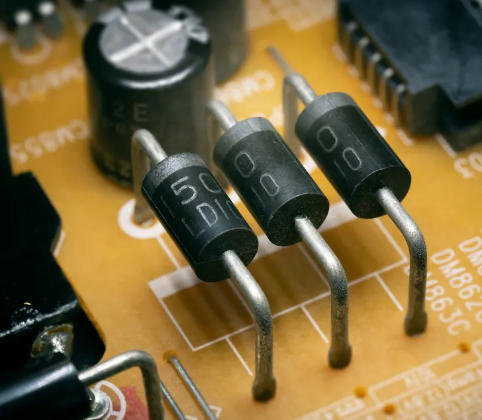A diode is a semiconductor device with unidirectional conductivity, typically composed of P-type and N-type semiconductor materials, forming a PN junction. Its core function is to allow current to flow in one direction (forward conduction) while blocking current when a voltage is applied in the reverse direction (reverse blocking).
In PCB design, diodes are widely used in the following areas:
Rectification: Converts alternating current (AC) to direct current (DC), commonly found in power supply circuits.
Protection circuits: These devices, such as reverse polarity protection and overvoltage protection, prevent damage to circuit components due to incorrect connections or voltage spikes.
Signal modulation and demodulation: Used for signal processing in communications circuits.
Logic circuits: Implement simple logic functions in some digital circuits.
Light-emitting and photosensitive: Light-emitting diodes (LEDs) and photodiodes are widely used in display and sensing applications.

diode
In PCB design, choosing the appropriate diode type based on specific application requirements is crucial. The following are several common diodes and their characteristics:
Rectifier diodes: Such as the 1N4007 series, are suitable for power supply rectification and have high current-carrying capacity. Schottky diodes, such as the BAT54, feature low forward voltage drop and fast switching characteristics, making them suitable for high-frequency circuits and low-voltage applications.
Zener diodes are used for voltage regulation and overvoltage protection, stabilizing voltage through their reverse breakdown characteristics.
Light-emitting diodes (LEDs) are widely used for status indication, lighting, and displays.
TVS diodes are transient voltage suppressor diodes used to protect circuits from transient voltage surges, such as lightning strikes or electrostatic discharge (ESD).
Dielectromechanical characteristics (e.g., forward voltage drop, reverse breakdown voltage, switching speed, etc.) must be optimized during PCB layout and selection.
In PCB design, diode layout and selection directly impact circuit performance and reliability. Here are some key design considerations:
Thermal Management: Diodes generate heat when conducting, especially in high-current applications. Designers should ensure adequate space around the diode for heat dissipation and consider using heat sinks or thermal vias to reduce temperature.
Parasitic Effects: In high-frequency circuits, the parasitic capacitance and inductance of diodes can affect signal integrity. Keep lead lengths as short as possible and place the diode close to the signal source or load.
Current and Voltage Matching: When selecting a diode, ensure its rated current and reverse voltage withstand meet the circuit requirements. For example, in a power rectifier circuit, consider input voltage fluctuations and potential inrush currents.
Polarity Identification: The polarity of the diode must be clearly marked on the PCB to avoid assembly errors. Common marking methods include silkscreen marking or adding a cathode marking on the PCB.
Electromagnetic Compatibility (EMC): In high-frequency or switching power supply applications, the rapid switching of diodes may generate electromagnetic interference (EMI).
This interference can be suppressed by adding filter capacitors or ferrite beads.
1. Power Rectification Circuit
In switching power supply designs, rectifier diodes (such as Schottky diodes) are used to convert AC input to DC output. For example, in a 12V DC power supply design, selecting a Schottky diode with a low forward voltage drop can significantly improve efficiency. Proper PCB layout (such as increasing the copper area) can also optimize heat dissipation.
2. Reverse Polarity Protection
In automotive electronics and portable devices, diodes are often used to prevent reverse power connection and circuit damage. For example, connecting a rectifier diode in series with the power input can effectively protect subsequent circuits, but the effect of the diode's forward voltage drop on efficiency should be considered.
3. LED Driver Circuit
LEDs are widely used in PCB design for status indication or illumination. Designs require appropriate current-limiting resistors and ensure that the LED's forward current and voltage meet specifications. Furthermore, LED layout should be strategically implemented to prevent light from interfering with other photosensitive components.
As electronic products evolve towards miniaturization, higher efficiency, and higher frequencies, PCB diode design faces new challenges. For example, 5G communications and high-performance computing devices require diodes with faster switching speeds and lower power consumption. Furthermore, new semiconductor materials (such as silicon carbide (SiC) and gallium nitride (GaN)) are driving the development of high-performance diodes suitable for applications at higher voltages and temperatures.